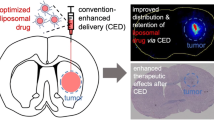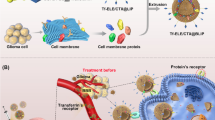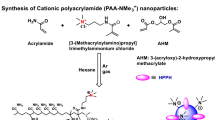Abstract
Brain tumor lacks effective delivery system for treatment. Focused ultrasound (FUS) can reversibly open BBB without impacts on normal tissues. As a potential drug carrier, cationic liposomes (CLs) have the ability to passively accumulate in tumor tissues for their positive charge. In this study, FUS introduced doxorubicin-loaded cationic liposomes (DOX-CLs) were applied to improve the efficiency of glioma-targeted delivery. Doxorubicin-loaded CLs (DOX-CLs) and quantum dot-loaded cationic liposomes (QD-CLs) were prepared using extrusion technology, and their characterizations were evaluated. With the advantage of QDs in tracing images, the glioma-targeted accumulation of FUS + CLs was evaluated by fluorescence imaging and flow cytometer. Cell survival rate, tumor volume, animal survival time, and brain histology in C6 glioma model were investigated to evaluate the glioma-targeted delivery of FUS + DOX-CLs. DOX-CLs and QD-CLs had suitable nanoscale sizes and high entrapment efficiency. The combined strategy of FUS introduced CLs significantly increased the glioma-targeted accumulation for load drugs. FUS + DOX-CLs showed the strongest inhibition on glioma based on glioma cell in vitro and glioma model in vivo experiments. From MRI and histological analysis, FUS + DOX-CLs group strongly suppressed the glioma progression and extended the animal survival time to 81.2 days. Among all the DOX treatment groups, FUS + DOX-CLs group showed the best cell viability and highest level of tumor apoptosis and necrosis. Combining the advantages of BBB reversible opening by FUS and glioma-targeted binding by CLs, ultrasound introduced cationic liposomes could achieve glioma-targeted delivery, which might be developed as a potential strategy for future brain tumor therapy.






Similar content being viewed by others
Abbreviations
- DOX:
-
Doxorubicin
- CLs:
-
Cationic liposomes
- FUS:
-
Focused ultrasound
- MRI:
-
Magnetic resonance images
- DOX-CLs:
-
Doxorubicin-loaded cationic liposomes
- QD:
-
Quantum dots
- QD-CLs:
-
QD-loaded cationic liposomes
References
Louis DN, Ohgaki H, Wiestler OD, Cavenee WK, Burger PC, Jouvet A, Scheithauer BW, Kleihues P (2007) The 2007 WHO classification of tumours of the central nervous system. Acta Neuropathol 114:97–109
Schneider T, Mawrin C, Scherlach C, Skalej M, Firsching R (2010) Glioma in adults. Dtsch Arztebl Int 107:799–807
Larjavaara S, Mäntylä R, Salminen T, Haapasalo H, Raitanen J, Jääskeläinen J, Auvinen A (2007) Incidence of glioma by anatomic location. Neuro Oncol 9:319–325
Liu X, Cui W, Li B, Hong Z (2012) Targeted therapy for glioma using cyclic RGD-entrapped polyionic complex nanomicelles. Int J Nanomed 7:2853–2862
Stan AC, Casares S, Radu D, Walter GF, Brumeanu TD (1999) Doxorubicin-induced cell death in highly invasive human gliomas. Anticancer Res 19:941–950
Walter KA, Tamargo RJ, Olivi A, Burger PC, Brem H (1995) Intratumoral chemotherapy. Neurosurgery 37:1128–1145
Voulgaris S, Partheni M, Karamouzis M, Dimopoulos P, Papadakis N, Kalofonos HP (2002) Intratumoral doxorubicin in patients with malignant brain gliomas. Am J Clin Oncol 25:60–64
Laquintana V, Trapani A, Denora N, Wang F, Gallo JM, Trapani G (2009) New strategies to deliver anticancer drugs to brain tumors. Expert Opin Drug Deliv 6(10):1017–1032
Hynynen K, McDannold N, Vykhodtseva N, Jolesz FA (2001) Noninvasive MR imaging-guided focal opening of the blood-brain barrier in rabbits. Radiology 220:640–646
Choi JJ, Pernot M, Small SA, Konofagou EE (2007) Noninvasive, transcranial and localized opening of the blood-brain barrier using focused ultrasound in mice. Ultrasound Med Biol 33:95–104
O’Reilly MA, Waspe AC, Ganguly M, Hynynen K (2011) Focused-ultrasound disruption of the blood–brain barrier using closely-timed short pulses: influence of sonication parameters and injection rate. Ultrasound Med Biol 37:587–594
Sheikov N, McDannold N, Sharma S, Hynynen K (2008) Effect of focused ultrasound applied with an ultrasound contrast agent on the tight junctional integrity of the brain microvascular endothelium. Ultrasound Med Biol 34:1093–1104
Vlachos F, Tung Y-S, Konofagou E (2011) Permeability dependence study of the focused ultrasound-induced blood–brain barrier opening at distinct pressures and microbubble diameters using DCE-MRI. Magn Reson Med 66:8218–8230
Shang X, Wang P, Liu Y, Zhang Z, Xue Y (2011) Mechanism of low-frequency ultrasound in opening blood-tumor barrier by tight junction. J Mol Neurosci 43:364–369
Sheikov N, McDannold N, Vykhodtseva N, Jolesz F, Hynynen K (2004) Cellular mechanisms of the blood–brain barrier opening induced by ultrasound in presence of microbubbles. Ultrasound Med Biol 30:979–989
Hynynen K, Jolesz FA (1998) Demonstration of potential noninvasive ultrasound brain therapy through an intactskull. Ultrasound Med Biol 24:275–283
Aubry JF, Tanter M, Pernot M, Thomas JL, Fink M (2003) Experimental demonstration of noninvasive trans-skull adaptive focusing based on prior computed tomography scans. J Acoust Soc Am 113:84–93
Hynynen K, McDannold N, Clement G, Jolesz FA, Zadicario E, Killiany R, Moore T, Rosen D (2006) Preclinical testing of a phased array ultrasound system for MRI-guided noninvasive surgery of the brain-A primate study. Eur J Radiol 59:149–156
Goldenberg Neil M, Steinberg Benjamin E (2010) Surface charge: a key determinant of protein localization and function. Cancer Res 70:1277–1280
Hirko A, Tang F, Hughes JA (2003) Cationic lipid vectors for plasmid DNA delivery. Curr Med Chem 10:1185–1193
Bally MB, Masin D, Nayar R, Cullis PR, Mayer LD (1994) Transfer of liposomal drug carriers from the blood to the peritoneal cavity of normal and ascitic tumor-bearing mice. Cancer Chemother Pharmacol 34:137–146
Huang SK, Lee KD, Hong K, Friend DS, Papahadjopolous D (1992) Microscopic localization of sterically stabilized liposomes in colon carcinoma-bearing mice. Cancer Res 52:5135–5143
Huang SK, Martin FJ, Jay G, Vogel J, Papahadjopolous D, Friend DS (1993) Extravasation and transcytosis of liposomes in Kaposi’s sarcoma-like dermal lesions of transgenic mice bearing the HIV tat gene. Am J Pathol 143:10–14
Jovin TM (2003) Quantum dots finally come of age. Nat Biotechnol 21:32–33
Haran G, Cohen R, Bar LK, Barenholz Y (1993) Transmembrane ammonium sulfate gradients in liposomes produce efficient and stable entrapment of amphipathic weak bases. Biochim Biophys Acta 1151:201–215
Golubenko TA (1991) Low-frequency ultrasound in the treatment of osteoarthrosis patients. Vopr Kurortol Fizioter Lech Fiz Kult 2:36–39
Serena T, Lee SK, Lam K, Attar P, Meneses P, Ennis W (2009) The impact of noncontact, nonthermal, low-frequency ultrasound on bacterial counts in experimental and chronic wounds. Ostomy Wound Manage 55:22–30
Claes L, Willie B (2007) The enhancement of bone regeneration by ultrasound. Prog Biophys Mol Biol 93:384–398
Behrens S, Daffertshofer M, Spiegel D, Hennerici M (1999) Low frequency, low-intensity ultrasound accelerates thrombolysis through the skull. Ultrasound Med Biol 25:269–273
McDannold N, Vykhodtseva N, Hynynen K (2008) Effects of acoustic parameters and ultrasound contrast agent dose on focused-ultrasound induced blood–brain barrier disruption. Ultrasound Med Biol 34:930–937
Kroll RA, Neuwelt EA (1998) Outwitting the blood–brain barrier for therapeutic purposes: osmotic opening and other means. Neurosurgery 42:1083–1100
Anajafi T, Mallik S (2015) Polymersome-based drug-delivery strategies for cancer therapeutics. Ther Deliv 4:521–534
Tahover E, Patil YP, Gabizon AA (2015) Emerging delivery systems to reduce doxorubicin cardiotoxicity and improve therapeutic index: focus on liposomes. Anticancer Drugs 26:241–258
Itakura S, Hama S, Ohgita T, Kogure K (2014) Development of nanoparticles incorporating a novel liposomal membrane destabilization peptide for efficient release of cargos into cancer cells. PLoS One 9(10):111–181
Qu MH, Zeng RF, Fang S, Dai QS, Li HP, Long JT (2014) Liposome-based co-delivery of siRNA and docetaxel for the synergistic treatment of lung cancer. Int J Pharm 474:112–122
Gifford I, Vreeland W, Grdanovska S, Burgett E, Kalinich J, Vergara V, Wang CK, Maimon E, Poster D, Al-Sheikhly M (2014) Liposome-based delivery of a boron-containing cholesteryl ester for high-LET particle-induced damage of prostate cancer cells: a boron neutron capture therapy study. Int J Radiat Biol 90:480–485
Zheng H, Hu Y, Huang W, de Villiers S, Pentel P, Zhang J, Dorn H, Ehrich M, Zhang C (2015) Negatively charged carbon nanohorn supported cationic liposome nanoparticles: a novel delivery vehicle for anti-nicotine vaccine. J Biomed Nanotechnol 11(12):2197–2210
Tada R, Hidaka A, Iwase N, Takahashi S, Yamakita Y, Iwata T, Muto S, Sato E, Takayama N, Honjo E, Kiyono H, Kunisawa J, Aramaki Y (2015) Intranasal immunization with DOTAP cationic liposomes combined with DC-cholesterol induces potent antigen-specific mucosal and systemic immune responses in mice. PLoS one 10(10):e0139785
Dicheva BM, ten Hagen TL, Schipper D, Seynhaeve AL, van Rhoon GC, Eggermont AM, Koning GA (2014) Targeted and heat-triggered doxorubicin delivery to tumors by dual targeted cationic thermosensitive liposomes. J Control Release 10(195):37–48
Chaudhary AK, Yadav N, Bhat TA, O’Malley J, Kumar S, Chandra D (2015) A potential role of X-linked inhibitor of apoptosis protein in mitochondrial membrane permeabilization and its implication in cancer therapy. Drug Discov Today S1359–6446:285–288
Acknowledgments
This research was supported by the National Natural Science Foundation of China (Grant Nos. 81360195, 81301982, 81571392, and 81272160), Zhejiang Provincial Natural Science Foundation of China (Grant No. LY12H31003), Zhejiang Provincial Foundation for Health Department (Grant No. 2015ZDA023), Medicine Grant from Wenzhou Bureau of Science and Technology (Grant Nos. Y2014730 and Y20140726). Major Scientific Project of Guangdong Province(Grant No. 2012A080201010). Science and Technology Program of Guangzhou, China (201508020001).
Author information
Authors and Affiliations
Corresponding authors
Ethics declarations
Conflict of interest
The authors report no conflicts of interest. The authors alone are responsible for the content and writing of this paper.
Electronic supplementary material
Below is the link to the electronic supplementary material.
280_2015_2926_MOESM1_ESM.tif
Fig. S1 Kaplan–Meier survival curves for the animals in different experimental groups. Supplementary material 1 (TIFF 20 kb)
280_2015_2926_MOESM2_ESM.tif
Fig. S2 TUNEL staining analysis for different experimental groups. *P < 0.05 and **P < 0.01 versus control group. Supplementary material 2 (TIFF 20 kb)
Rights and permissions
About this article
Cite this article
Lin, Q., Mao, KL., Tian, FR. et al. Brain tumor-targeted delivery and therapy by focused ultrasound introduced doxorubicin-loaded cationic liposomes. Cancer Chemother Pharmacol 77, 269–280 (2016). https://doi.org/10.1007/s00280-015-2926-1
Received:
Accepted:
Published:
Issue Date:
DOI: https://doi.org/10.1007/s00280-015-2926-1




